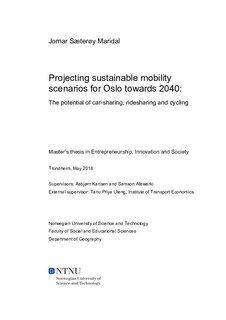| dc.description.abstract | Pushing towards achieving a sustainable mobility future, policy-makers have introduced a zerogrowth objective for car traffic in a number of urban areas in Norway, including Oslo. It stipulates that all future traffic growth is to be absorbed by public transport, walking and cycling. Taking into account Oslo’s projected population growth and expected shifting age distribution through combining it with empirical evidence on different demographic groups’ travel habits, this thesis sets out to investigate how the zero-growth objective possibly can be achieved for all by projecting future mobility scenarios. It finds that if current travel habits remain unchanged, almost 100,000 daily car trips will need to be substituted onto public transport, walking or cycling by 2040 in Oslo alone. Assessing what it will take for such a transition to happen, this thesis finds that the various demographic groups in Oslo will require vastly different growth rates in public transport, walking and cycling ridership at the expense of car travel in order to meet and maintain the zero-growth objective. This is found due to strong deviations between the groups’ travel habits, expected willingness to substitute one mode of transport with another, and an uneven population growth rate.
In an effort to abridge the demographic variations in zero-growth obtainment for car travel, the application of car-sharing, ridesharing and cycling is also assessed in terms of their potential as agents for furthering sustainable mobility. These modes have in common that they offer innovative aspects to the mobility picture and thus might serve as covetable alternatives for demographic groups projected to resist shifts onto the modes of transport proposed through the zero-growth objective. A back-cast discussion on their future role based on empirical data and theoretical underpinnings finds that car-sharing and ridesharing have some, albeit limited potential in furthering sustainable mobility in Oslo. Their potential lies in that the demographic groups that currently show the strongest propensity towards them correspond to those projected to resist shifts onto other sustainable modes of transport. Their limitations lie in that they are car-based modes, and as such need to be applied in moderation, preferably when shifts onto other sustainable modes have been exhausted in order to uphold the zero-growth objective. Cycling on the other hand has no such restrictions, yet despite policy makers favouring it the mode has proven only moderately successful in absorbing car traffic to date. Cycling’s potential application as an agent of furthering sustainable mobility is therefore found to largely be in recent improvements to it, like EL-cycling and city bike schemes; both constituting innovations that may help expand upon its current market share. | nb_NO |
